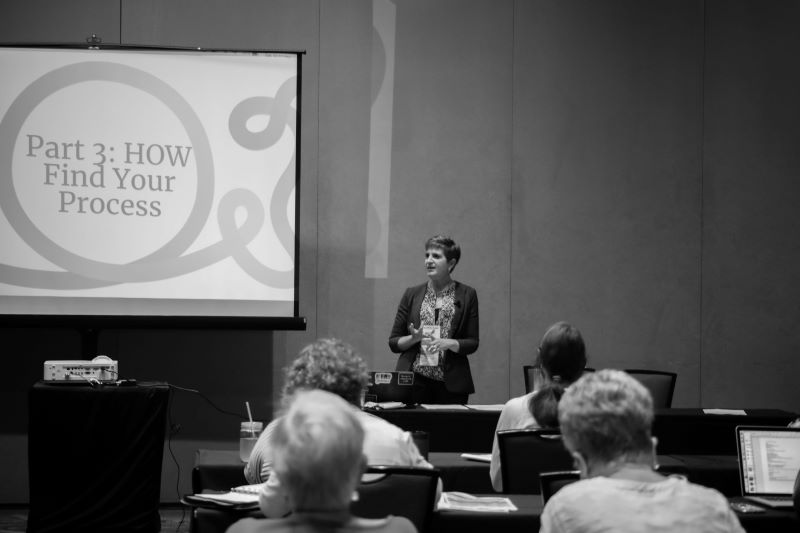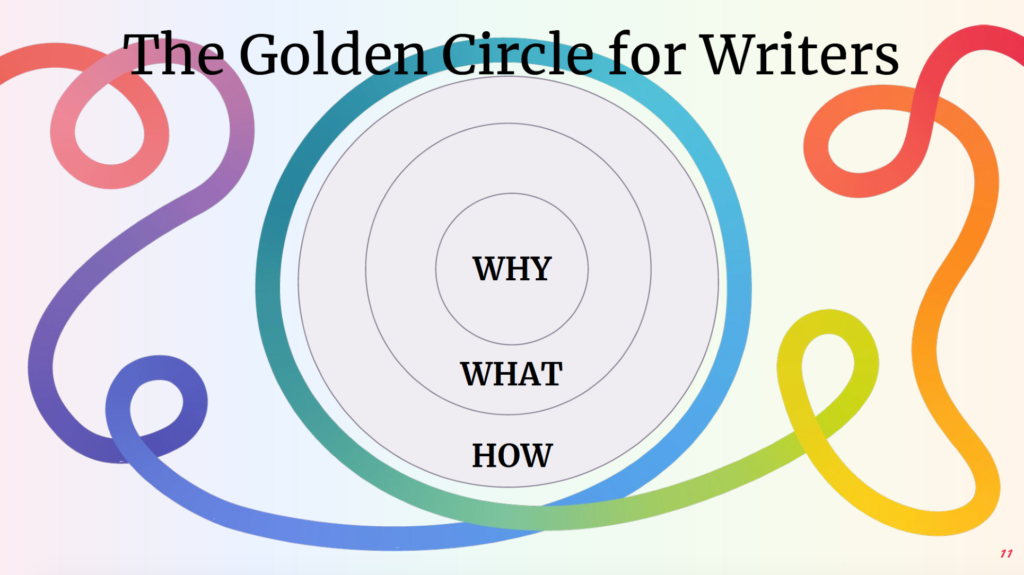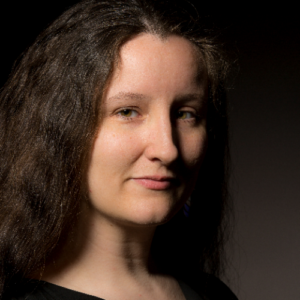This post is part of a HippoCamp 2021 recap series, with guest blog posts written by HippoCamp attendees. Learn more about our conference for creative nonfiction writers.

Leanne Sowul at HippoCamp 2021. Photo by Lina Seijo for Hippocampus Magazine.
At the beginning of her HippoCamp 2021 presentation, Leanne Sowul asked the attendees: “Is it possible to have a productive writing life that brings you joy while (1) caring for other humans, (2) caring for your own wellness, and (3) working a non-writing job?” If answering “yes” sounds a little far-fetched to you, you’re not the only one.
Start with Why
Referencing Simon Sinek’s TED Talk “Start with Why” and the book of the same name, Leanne walked attendees through the writer’s Golden Circle. Start with Why, then consider What, and finally figure out How. Using a worksheet she handed out at the beginning of the presentation, Leanne encouraged attendees to write their personal purpose statement. A great purpose statement, she said, (1) must be concise, (2) must speak from the heart, and (3) must represent your values, priorities, creative strengths, and passions. She gave her own purpose statement as an example and explained that while the statement itself may not seem like it has anything to do with writing at first glance, it’s the Why underneath the writing that matters. When writing your own purpose statement, consider:
- Why do you create?
- Why do you write?
- Why do your favorite pieces of writing influence you?
- Why do you feel passionate about certain topics?
- Why did past pieces of your work connect strongly with you and your audience?

A slide from Leanne’s presentation, which depicts Simon Sinek’s “Start With Why” concept.
Find Your Focus
After coming up with a personal purpose statement, Leanne reminded attendees that while Simon Simek’s Golden Circle is Why/How/What, a writer’s Golden Circle is Why/What/How. Why is setting your intention; What is setting your goals; How is breaking down the goals into manageable habits and routines. It may actually feel a little like you’re being interviewed for a job during the What phase. First, start with the writing project that calls to you the most. Ask yourself the question: In what ways does my creativity most speak to me and the world? Then—and here’s the job interview part—think of your writing life two years from now, five years from now, and ten years from now. What do you imagine success would look like in those time periods? What accomplishments will you be most proud of?
Find Your Process
After you’ve got a solid foundation on which to build, Leanne said, you can begin building writing processes that work for you. Remember, though, that “you must take care of the writer before you take care of the writing.” Self-care is important in any successful process, and it includes proper sleep and exercise, hydration and nutrition, meditation (whether that means journaling or listening to contemplative audio or something else that works for you), and monitoring your mental health! With self-care in mind, the How phase consists of four steps: Plan, Work, Ruminate, and Reflect.
Plan
In the planning stage of How, a writer can use one (or more) of several monitoring options: Time, Output, and Reflection Questions. Measuring your goals with time means that you count how much time you’ve actually got your butt in the chair specifically for writing. Measuring with output means you can quit writing for the day after you’ve got a certain number of words, paragraphs, or pages completed. Reflection question encourage you as a writer to ask yourself if you’ve accomplished the daily goal (“write an entire scene,” etc.) after you come to a good stopping place.
Work
In order to write, you need three things: Time, Attention, and Space. If you think to yourself, “I’ll write when I have time,” you’ll never write because other things will keep you from having time, so make sure to schedule your writing just as you would any other appointment! Additionally, give your writing all of your attention—turn off all distractions and put a sign on your door to avoid being interrupted. Finally, you need space—an office or desk is ideal, but sometimes just putting on noise-cancelling headphones to create space between your ears will help when all else fails. Leanne even gave some pointers on what to do if you have a hard time getting started. For example, you can tell yourself you’re “just practicing” or write about why you’re not writing.
Ruminate and Reflect
Letting your mind wander, advises Leanne, is just as important as putting your butt in the chair to write in the first place. “Give your brain space to wander,” and you will be grateful for the creativity down the road. Finally, reflecting is the opposite of planning. Check in with yourself and your writing process to make sure you’re honoring your physical and mental health and your writing progress and achievements. You can reflect at the end of each week, month, or season, or all of the above.
Leanne’s Key Takeaways
If you don’t remember anything else from this presentation (and recap!), remember these three things, taken directly from Leanne’s presentation slides:
- Digging deep to find your true Why will create a foundation for your writing life and a roof for all your passion projects.
- Every goal you set, every project you take on should connect back to your Why, your writing purpose.
- You must take care of the writer before you take care of the writing. That is the key to a joyfully productive writing life.
Leanne Sowul, the Joyful Creative, can be found on her website, http://www.leannesowul.com and on Twitter and Instagram at @sowulwords.
 Viannah E. Duncan is a professional editor for academic, corporate, and creative writers. She specializes in writing, developmental editing, line editing, copyediting, proofreading, sensitivity reading, and literary coaching and has a soft spot for poetry and LGBTQ+ fiction and nonfiction. Ms. Duncan’s clients range from individuals just starting their writing journeys to independent publishing houses to corporations and government entities. She holds an MFA in creative writing with a focus on poetry, creative nonfiction, and small press publishing and has a small dog named Hyphen. She lives on stolen Piscataway land in what is now known as the area north of Washington, DC. You can find out more about her and her editing services at http://www.duncanheights.com.
Viannah E. Duncan is a professional editor for academic, corporate, and creative writers. She specializes in writing, developmental editing, line editing, copyediting, proofreading, sensitivity reading, and literary coaching and has a soft spot for poetry and LGBTQ+ fiction and nonfiction. Ms. Duncan’s clients range from individuals just starting their writing journeys to independent publishing houses to corporations and government entities. She holds an MFA in creative writing with a focus on poetry, creative nonfiction, and small press publishing and has a small dog named Hyphen. She lives on stolen Piscataway land in what is now known as the area north of Washington, DC. You can find out more about her and her editing services at http://www.duncanheights.com.

